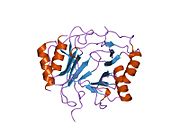Platelet factor 4
Ensembl | |||||||||
|---|---|---|---|---|---|---|---|---|---|
| UniProt | |||||||||
| RefSeq (mRNA) | |||||||||
| RefSeq (protein) | |||||||||
| Location (UCSC) | Chr 4: 73.98 – 73.98 Mb | Chr 5: 90.92 – 90.92 Mb | |||||||
| PubMed search | [3] | [4] | |||||||
| View/Edit Human | View/Edit Mouse |
Platelet factor 4 (PF4) is a small
.Genomics
The gene for human PF4 is located on human chromosome 4.[6]
Function
Platelet factor-4 is a 70-amino acid protein that is released from the alpha-granules of activated platelets and binds with high affinity to heparin. Its major physiologic role appears to be neutralization of heparin-like molecules on the endothelial surface of blood vessels, thereby inhibiting local antithrombin activity and promoting coagulation. As a strong chemoattractant for neutrophils and fibroblasts, PF4 probably has a role in inflammation and wound repair.[5][7]
PF4 is chemotactic for
Clinical significance
The heparin:PF4 complex is the antigen in
It is increased in patients with
The human platelet factor 4 kills
See also
References
- ^ a b c GRCh38: Ensembl release 89: ENSG00000163737 – Ensembl, May 2017
- ^ a b c GRCm38: Ensembl release 89: ENSMUSG00000029373 – Ensembl, May 2017
- ^ "Human PubMed Reference:". National Center for Biotechnology Information, U.S. National Library of Medicine.
- ^ "Mouse PubMed Reference:". National Center for Biotechnology Information, U.S. National Library of Medicine.
- ^ PMID 1695112.
- S2CID 8087808.
- ^ "Entrez Gene: PF4 platelet factor 4 (chemokine (C-X-C motif) ligand 4)".
- PMID 12782716.
- PMID 17329695.
- PMID 18589060.
- PMID 33835768.
- PMID 33835769.
- PMID 34061166.
- PMID 35027067.
- PMID 28038680.
- PMID 23245326.
Further reading
- Bikfalvi A, Gimenez-Gallego G (February 2004). "The control of angiogenesis and tumor invasion by platelet factor-4 and platelet factor-4-derived molecules". Seminars in Thrombosis and Hemostasis. 30 (1): 137–44. S2CID 260320397.
- Maurer AM, Zhou B, Han ZC (December 2006). "Roles of platelet factor 4 in hematopoiesis and angiogenesis". Growth Factors. 24 (4): 242–52. S2CID 36468865.
- Deuel TF, Keim PS, Farmer M, Heinrikson RL (June 1977). "Amino acid sequence of human platelet factor 4". Proceedings of the National Academy of Sciences of the United States of America. 74 (6): 2256–8. PMID 267922.
- Walz DA, Wu VY, de Lamo R, Dene H, McCoy LE (December 1977). "Primary structure of human platelet factor 4". Thrombosis Research. 11 (6): 893–8. PMID 601757.
- Nath N, Lowery CT, Niewiarowski S (April 1975). "Antigenic and antiheparin properties of human platelet factor 4 (PF4)". Blood. 45 (4): 537–50. PMID 803847.
- Hermodson M, Schmer G, Kurachi K (September 1977). "Isolation, crystallization, and primary amino acid sequence of human platelet factor 4". The Journal of Biological Chemistry. 252 (18): 6276–9. PMID 893407.
- Maione TE, Gray GS, Petro J, Hunt AJ, Donner AL, Bauer SI, et al. (January 1990). "Inhibition of angiogenesis by recombinant human platelet factor-4 and related peptides". Science. 247 (4938): 77–9. PMID 1688470.
- Han ZC, Bellucci S, Tenza D, Caen JP (April 1990). "Negative regulation of human megakaryocytopoiesis by human platelet factor 4 and beta thromboglobulin: comparative analysis in bone marrow cultures from normal individuals and patients with essential thrombocythaemia and immune thrombocytopenic purpura". British Journal of Haematology. 74 (4): 395–401. S2CID 24529258.
- Poncz M, Surrey S, LaRocco P, Weiss MJ, Rappaport EF, Conway TM, Schwartz E (January 1987). "Cloning and characterization of platelet factor 4 cDNA derived from a human erythroleukemic cell line". Blood. 69 (1): 219–23. PMID 3098319.
- Griffin CA, Emanuel BS, LaRocco P, Schwartz E, Poncz M (1987). "Human platelet factor 4 gene is mapped to 4q12----q21". Cytogenetics and Cell Genetics. 45 (2): 67–9. PMID 3622011.
- Senior RM, Griffin GL, Huang JS, Walz DA, Deuel TF (February 1983). "Chemotactic activity of platelet alpha granule proteins for fibroblasts". The Journal of Cell Biology. 96 (2): 382–5. PMID 6187750.
- Morgan FJ, Begg GS, Chesterman CN (February 1980). "Complete covalent structure of human platelet factor 4". Thrombosis and Haemostasis. 42 (5): 1652–60. PMID 6445090.
- Deuel TF, Senior RM, Chang D, Griffin GL, Heinrikson RL, Kaiser ET (July 1981). "Platelet factor 4 is chemotactic for neutrophils and monocytes". Proceedings of the National Academy of Sciences of the United States of America. 78 (7): 4584–7. PMID 6945600.
- Brown KJ, Parish CR (November 1994). "Histidine-rich glycoprotein and platelet factor 4 mask heparan sulfate proteoglycans recognized by acidic and basic fibroblast growth factor". Biochemistry. 33 (46): 13918–27. PMID 7524669.
- Mayo KH, Roongta V, Ilyina E, Milius R, Barker S, Quinlan C, et al. (September 1995). "NMR solution structure of the 32-kDa platelet factor 4 ELR-motif N-terminal chimera: a symmetric tetramer". Biochemistry. 34 (36): 11399–409. PMID 7547867.
- Barker S, Mayo KH (January 1995). "Quarternary structure amplification of protein folding differences observed in 'native' platelet factor-4". FEBS Letters. 357 (3): 301–4. S2CID 12222261.
- Zhang X, Chen L, Bancroft DP, Lai CK, Maione TE (July 1994). "Crystal structure of recombinant human platelet factor 4". Biochemistry. 33 (27): 8361–6. PMID 8031770.
- Horne MK (April 1993). "The effect of secreted heparin-binding proteins on heparin binding to platelets". Thrombosis Research. 70 (1): 91–8. PMID 8511754.
- Kolset SO, Mann DM, Uhlin-Hansen L, Winberg JO, Ruoslahti E (April 1996). "Serglycin-binding proteins in activated macrophages and platelets". Journal of Leukocyte Biology. 59 (4): 545–54. S2CID 23125881.
External links
- Platelet+factor+4 at the U.S. National Library of Medicine Medical Subject Headings (MeSH)
This article incorporates text from the United States National Library of Medicine, which is in the public domain.






